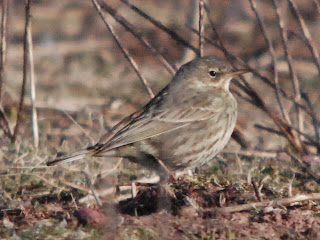I organised to spend a week on Skokholm 23rd to 30th March as a volunteer but didn't get on until Tuesday 26th due to the persistent easterlies. For the second time, I managed to team up with Mark Hipkin, who was great company, as were the new Wardens Richard and Giselle and the other Volunteers. The horribly persistent, freezing easterlies killed off most migration but the birding was brightened by a chance to really grill a wide range of Rock Pipits
Anthus petrosus, some of which appeared to show features of Scandinavian birds
ssp littoralis. They turned out to be brilliant value. Bouncing ideas off Richard and Mark made for a great learning experience. The first inkling of something interesting was when Mark saw a pipit near the Lighthouse where we were working. He described it as very Water Pipit-like with a pink flush on the breast and very clean white underparts. I caught up with what must have been the same bird a little later and was convinced it was a Scandinavian Rock Pipit, a male, at the brighter edge of the plumage range. It showed a clear grey head, mantle and back tones with neat understated darker lines, contrasting darker brown wings, very clean white underparts with strong dark streaking extending from the sides of the upper breast to rear of flanks. The unmarked throat was pale pink, this striking colour extending onto the upper breast and was bordered by the flank streaks. I was convinced it was a
littoralis bird, having seen spring birds previously on the east coast. Unfortunately neither Mark or I got a photo but it led to me spending a lot of time watching and trying to photograph Rock Pipits on the island. The bird below on East Bog was less stunningly obvious than the first, presumed male but is a good candidate nevertheless (accompanied by another very similar individual, which was just as convincing as
littoralis).
 |
| littoralis bird, one of two very similar birds together |
 |
| The same bird, very pale underparts. |
Unlike general
petrosus there is a quite marked difference between winter and spring plumage in
littoralis (though
petrosus can appear greyer and, paler below in spring and they can also, according to Richard's experience, acquire a 'peachy' wash on the breast, so care is clearly needed. The first, most striking feature of the bird above was the contrast between the brown wings and the grey back, mantle and head. On the whole,
petrosus birds don't seem to show much of a contrast between wings and back, though in bright sunlight the back and mantle can appear somewhat paler and show some contrast with worn brown wing feathers, but then soft green tones are still very noticeable. The underparts are generally yellower or buffer with apparently more diffuse, smudgy streaking. Birds with an obvious cleanly grey back and mantle, without any green or olive tones, and with very pale, whitish underparts contrastingly streaked on the flanks seemed a good prospect for
littoralis.
Rock Pipits undergo a full body moult in winter but retain worn wing and tail feathers which become faded brown, thus emphasising the contrast. There is at least one newly moulted tertial in the littoralis bird in the photo below but being very dark still, it seems to me, creates a still strong contrast with the clear pale grey back and mantle giving an effect quite unlike usual petrosus birds. Other interesting features are the strong, bright supercilium and the apparently paler than standard, pinker legs; though this can be a reflective effect sometimes seen on petrosus birds in sunlight, it has been mooted as a feature of at least some littoralis birds. To me, this bird, its companion and the, even brighter, male seen the day before are pretty good for Scandinavian Rock Pipits. At least one other bird appeared to have a darker reddish tint to the bottom of the ear coverts and maybe a little in the upper flank but unfortunately was not photographed.
Other birds seen and photographed were apparently intermediate, maybe bright petrosus or dull littoralis (there should be many more of these latter than the obvious birds I would imagine) but there was quite a bit of variety generally and a number were difficult to name with any confidence. Maybe there were just three littoralis birds or maybe a more significant passage through the Island during exceptional meteorological conditions, it's hard to be sure. Late March would be pretty much peak time for birds on the Norfolk coast as I recall.









No comments:
Post a Comment